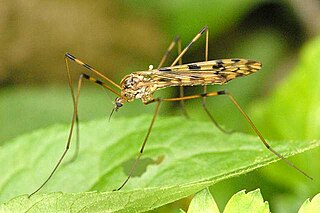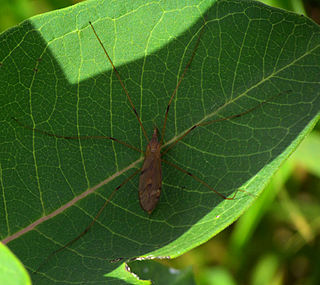Related Research Articles

A crane fly is any member of the dipteran superfamily Tipuloidea, which contains the living families Cylindrotomidae, Limoniidae, Pediciidae and Tipulidae, as well as several extinct families. "Winter crane flies", members of the family Trichoceridae, are sufficiently different from the typical crane flies of Tipuloidea to be excluded from the superfamily Tipuloidea.

Limoniidae is the largest of four crane fly families, with more than 10,700 species in more than 150 genera. It is a paraphyletic assemblage of genera within the superfamily Tipuloidea. Although paraphyletic, Limoniid crane flies can usually be distinguished by the way the wings are held at rest. Limoniids usually hold/fold the wings along the back of the body, whereas other crane flies usually hold them out at right angles. Snow flies such as Chionea scita have no wings at all. Limoniids are also usually smaller than other crane flies, with some exceptions.

The Chioneinae are a subfamily of limoniid crane flies.
Paleontology or palaeontology is the study of prehistoric life forms on Earth through the examination of plant and animal fossils. This includes the study of body fossils, tracks (ichnites), burrows, cast-off parts, fossilised feces (coprolites), palynomorphs and chemical residues. Because humans have encountered fossils for millennia, paleontology has a long history both before and after becoming formalized as a science. This article records significant discoveries and events related to paleontology that occurred or were published in the year 1869.

Discobola is a genus of crane fly in the family Limoniidae.

Limonia is a genus of crane flies in the family Limoniidae. There are at least 430 described species in Limonia. It is somewhat of a 'catch-all' genus, where some members should rightly be placed elsewhere.
Lipsothrix is a genus of crane fly in the family Limoniidae.
Maietta is a genus of crane fly in the family Limoniidae.
Medleromyia is a genus of crane fly in the family Limoniidae.

Metalimnobia is a genus of crane fly in the family Limoniidae.
Metalimnophila is a genus of crane fly in the family Limoniidae.
Neocladura is a genus of crane fly in the family Limoniidae.
Thaumastoptera is a genus of crane fly in the family Limoniidae.
Tonnoiraptera is a genus of crane fly in the family Limoniidae.
Trichoneura is a genus of crane fly in the family Limoniidae.

The Pediciidae or hairy-eyed craneflies are a family of flies closely related to true crane flies, with about 500 species worldwide.

Maekistocera is a genus of true crane fly.
Limonia yakushimensis is a crane fly in the family Limoniidae. The species occurs in the Palearctic region. L. yakushimensis is known to rear its young in the fruit bodies of the fungus Lactarius volemus.

Eriopterini is a tribe of limoniid crane flies in the family Limoniidae. There are more than 20 genera and 3,800 described species in Eriopterini.

Limoniini is a tribe of limoniid crane flies in the family Limoniidae. There are about 7 genera and more than 1,400 described species in Limoniini.
References
- "Catalogue of the Craneflies of the World (Diptera, Tipuloidea: Pediciidae, Limoniidae, Cylindrotomidae, Tipulidae)". Naturalis Biodiversity Center.